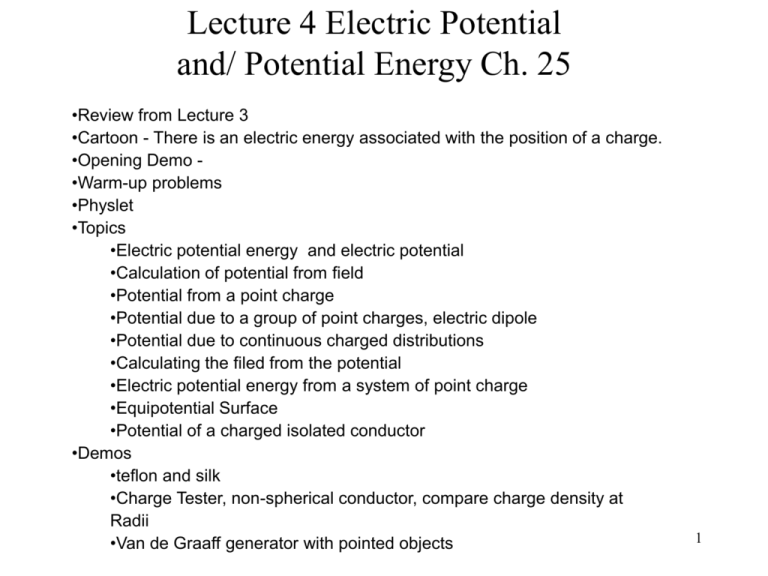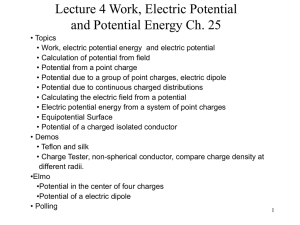Lecture 4 Electric potential
advertisement

Lecture 4 Electric Potential and/ Potential Energy Ch. 25 •Review from Lecture 3 •Cartoon - There is an electric energy associated with the position of a charge. •Opening Demo •Warm-up problems •Physlet •Topics •Electric potential energy and electric potential •Calculation of potential from field •Potential from a point charge •Potential due to a group of point charges, electric dipole •Potential due to continuous charged distributions •Calculating the filed from the potential •Electric potential energy from a system of point charge •Equipotential Surface •Potential of a charged isolated conductor •Demos •teflon and silk •Charge Tester, non-spherical conductor, compare charge density at Radii •Van de Graaff generator with pointed objects 1 2 QuickTime™ and a TIFF (Uncompressed) decompressor are needed to see this picture. 3 QuickTime™ and a TIFF (Uncompressed) decompressor are needed to see this picture. 4 Potential Energy and Electric potential • The electric force is mathematically the same as gravity so it too must be a conservative force. We will find it useful to define a potential energy as is the case for gravity. Recall that the change in the potential energy in moving from one point a to point b is the negative of the work done by the electric force. b • U Ub Ua = - W = -Work done by the electric force = F ds b • Since F q0 E , a U =q0 E ds and a • Electric Potential difference = Potential energy change/ unit charge V • U q0 SI unit of electric potential is volt (V): 1 Volt = 1 Joule/Coulomb (1 V = 1 J/C) V Vb Va E ds (independent of path, ds) • Joule is too large a unit of energy when working at the atomic or molecular level, so use the electron-volt (eV), the energy obtained when an electron moves through a potential difference of 1 V. 1 eV = 1.6 x 10-19 J 5 f U U f Ui = - Work done by the electric force = F ds i y V U q x V Vf Vi E ds (independent of path, ds) Therefore, electric force is a conservative force. 6 W F V ds E ds q0 q0 •The potential difference is the negative of the work done per unit charge by an electric field on a positive unit charge when it moves from one point to another. • V is a scalar not a vector. Simplifies solving problems. •We are free to choose V to be 0 at any location. Normally V is chosen to be 0 at the negative terminal of a battery or 7 0 at infinity for a point charge. Example of finding the potential difference in a Uniform Field What is the electric potential difference for a unit positive charge moving in an uniform electric field from a to b? E E d a x direction b b b a a V E ds E dx E ( xb xa) V Ed U qV dV Edx E dV / dx d U qEd 8 Example for a battery in a circuit • In a 9 volt battery, typically used in IC circuits, the positive terminal has a potential 9 v higher than the negative terminal. If one micro-Coulomb of positive charge flows through an external circuit from the positive to negative terminal, how much has its potential energy been changed? V q U Vb Va (0 9)V q U 9q ( 9V ) 1 106 C U 9 10 6 Joules U 9 microJoules = 9 J 9 J Potential energy is lower by We also assumed that the potential at b was 0 9 Example of a proton accelerated in a uniform field A proton is placed in an electric field of E=105 V/m and released. After going 10 cm, what is its speed? Use conservation of energy. a b E = 105 V/m d = 10 cm 2qEd v m + 2 1.6 10 19 C 10 5 Vm 0.1m 1.67 10 27 kg V Vb Va Ed U qV qEd v U K 0 K U m v 1.4 10 s 8 K qEd 1 2 mv qEd 2 10 What is the electric potential when moving from one point to another in a field due to a point charge? V E dr kq E 2 r̂ r f Vf Vi E dr i 11 Potential of a point charge at a distance R f Vf Vi E dr̂ i 1 1 1 1 V f Vi E dr̂ kq cos 0 2 dr kq kq( ) r rR R R R q V f Vi 0 Vi k R kq V R 1 k 4 0 Replace R with r 1 q V 4 0 r eqn 25-26 12 Electric potential for a positive point charge kq V (r) r r x 2 y2 • V is a scalar • V is positive for positive charges, negative for negative charges. • r is always positive. • For many point charges, the potential at a point in space is the simple algebraic sum (Not a vector sum) 13 Electric potential due to a positive point charge Hydrogen atom. • What is the electric potential at a distance of 0.529 A from the proton? 1A= 10-10 m 8.99 109 Nm2 1.6 10 19 C 2 kq C V R .529 10 10 m V 27.2 r = 0.529 A J 27.2Volts C What is the electric potential energy of the electron at that point? U = qV= (-1.6 x 10-19 C) (27.2 V)= - 43.52 x 10-19 J or - 27.2 eV where eV stands for electron volts. Total energy of the electron in the ground state of hydrogen is - 13.6 eV 14 Also U= 2E = -27.2 eV. This agrees with above formula. What is the electric potential due to several point charges? • For many point charges, the potential at a point in space is the simple algebraic sum (Not a vector sum) kqi V ri i y q2 q1 r1 q1 q 2 q 3 V k r1 r 2 r 3 r2 r3 q3 x 15 QuickTime™ and a TIFF (Uncompressed) decompressor are needed to see this picture. 16 Potential due to a dipole For two point charges, the total potential is the sum of the potentials of each point charge. So, Vdipole Vtotal Va Vb q ( q) Vdipole Va Vb k r r b a rb ra kq r r ab We are interested in the regime where r>>d. As in fig 2, ra and rb are nearly parallel. And the difference in their length is dcos.Also because r>>d, ra rb is approximately r2. Vdipole d cos kq r2 kp cos r2 where p is the dipole moment. 17 QuickTime™ and a TIFF (Uncompressed) decompressor are needed to see this picture. 18 Potential due to a ring of charge • • Direct integration. Since V is a scalar, it is easier to evaluate V than E. Find V on the axis of a ring of total charge Q. Use the formula for a point charge, but replace q with elemental charge dq and integrate. Point charge kq V r For an element of charge dq, dV kdq r r is a constant as we integrate. V kdq r kdq (z 2 R 2 ) k (z R ) 2 2 dq V k (z R ) This is simpler than finding E because V is not a vector. 2 2 Q 19 Potential due to a line charge We know that for an element of charge dq dq the potential is dV k r For the line charge let the charge density be . Then dq=dx So, dV k dx r Then , dV k But, r x 2 d2 dx x 2 d2 Now, we can find the total potential V produced by the rod at point P by integrating along the length of the rod from x=0 to x=L L L V dV k 0 0 dx x d 2 L 2 k 0 dx x d 2 So, V k(ln( L L2 d2 ) ln d) V k ln(x x d ) 2 2 2 L 0 L L2 d 2 Or, V k ln d 20 A new method to find E if the potential is known. If we know V, how do we find E? V E ds dV E ds ˆ ĵdy k̂dz ds idx dV E x dx E y dy E z dz dV dx dV Ey dy dV Ez dz Ex E Ex iˆ Ey ĵ Ez k̂ So the x component of E is the derivative of V with respect to x, etc. –If V = a constant, then Ex = 0. The lines or surfaces on which V remains constant are called equipotential lines or surfaces. –See example on next slide 21 Equipotential Surfaces • Three examples • What is the obvious equipotential surface and equipotential volume for an arbitrary shaped charged conductor? • See physlet 9.3.2 Which equipotential surfaces fit the field lines? 22 x Blue lines are the electric field lines Orange dotted lines represent the equipotential surfaces a) Electric Dipole (ellipsoidal concentric shells) b) Point charge (concentric shells) c) Uniform E field E Ex , Ey 0, Ez 0 dV dx V Ex d Ex V = constant in y and z directions 23 QuickTime™ and a TIFF (Uncompressed) decompressor are needed to see this picture. 24 QuickTime™ and a TIFF (Uncompressed) decompressor are needed to see this picture. 25 Dielectric Breakdown: Application of Gauss’s Law If the electric field in a gas exceeds a certain value, the gas breaks down and you get a spark or lightning bolt if the gas is air. In dry air at STP, you get a spark when 4 V E 3 10 cm V = constant on surface of conductor Radius r2 r1 1 2 26 This explains why: • Sharp points on conductors have the highest electric fields and cause corona discharge or sparks. • Pick up the most charge with charge tester from the pointy regions of the non-spherical conductor. • Use non-spherical metal conductor charged with teflon rod. Show variation of charge across surface with charge tester. Radius R V = constant on surface of conductor 1 + Cloud + + + - - - 2 Van de Graaff - 27 How does a conductor shield the interior from an exterior electric field? • Start out with a uniform electric field with no excess charge on conductor. Electrons on surface of conductor adjust so that: 1. E=0 inside conductor 2. Electric field lines are perpendicular to the surface. Suppose they weren’t? s 3. Does E = 0 just outside the conductor 4. Is suniform over the surface? 5. Is the surface an equipotential? 6. If the surface had an excess charge, how would your answers change? 28 A metal slab is put in a uniform electric field of 106 N/C with the field perpendicular to both surfaces . – Show how the charges are distributed on the conductor. – Draw the appropriate pill boxes. – What is the charge density on each face of the slab? – Apply Gauss’s Law. qin E da 0 29 What is the electric potential of a uniformly charged circular disk? We can treat the disk as a set of ring charges. The ring of radius R’ and thickness dR’ has an area of 2R’dR’ and it’s charge is dq = sdA = s(2R’)dR’ where s=Q/(R2), the surface charge density. The potential due to the charge on this ring at point P given by k V Q 2 2 ( z (R' ) ) The potential dV at a point P due to the charged ring of radius R’ is kdq ks2R' dR' dV ( z 2 (R' )2 ) ( z 2 (R' )2 ) Integrating R’ from R’=0 to R’=R R V 0 ks2R' dR' ( z 2 (R' )2 ) V 2ks( z 2 R2 z) 30






